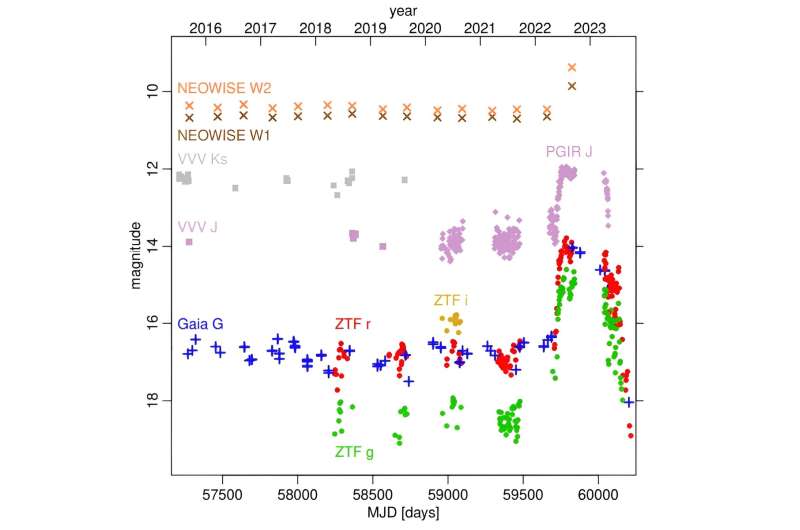January 24, 2024 report
This article has been reviewed according to Science X's editorial process and policies. Editors have highlighted the following attributes while ensuring the content's credibility:
fact-checked
preprint
trusted source
proofread
Astronomers observe accretion outburst of a young variable star

Using various ground-based facilities and space telescopes, astronomers have observed an accretion outburst that recently occurred on a young variable star known as V1741 Sgr. Results of the observations, published January 17 on the pre-print server arXiv, shed more light on the nature of this star.
V1741 Sgr (other designations: SPICY 71482 and Gaia22dtk) is a classical T Tauri variable star located in the vicinity of the young star cluster NGC 6530, dubbed the Lagoon Nebula. The source was first reported as a variable in 1957 and after years of stability, its first outburst was recorded in mid-2022 with ESA's Gaia satellite.
Studies of the recent outburst of V1741 Sgr suggested that it may be a young stellar object (YSO)—a star in an early stage of evolution. Observations show that episodic accretion processes occur in YSOs, thus these objects may experience accretion-driven outbursts.
Astronomers usually divide such events into EX Lup (also known as EXors) and FU Ori outbursts (or FUors). EXors are a few magnitudes in amplitude, and last from a few months to one or two years; FUors are more extreme and rare, can be up to 5 to 6 magnitudes in amplitude and last from decades to even centuries.
A team of astronomers led by Michael A. Kuhn of the University of Hertfordshire, UK, has performed photometry and spectroscopy V1741 Sgr, using instruments such as Gaia, Zwicky Transient Facility (ZTF) or NASA's Infrared Telescope Facility (IRTF). The main aim of their study was to explore the observed outburst, hoping to determine the true nature of V1741 Sgr.
The study found that the outburst of V1741 Sgr was an EX Lup-type event of moderate amplitude—about 3.0 mag in the optical and 1–2 mag in the infrared. The outbursting spectrum displays strong atomic and molecular emission, and also showcases brightening across the entire observed range.
According to the researchers, the most notable change in V1741 Sgr's spectrum was the appearance and subsequent disappearance of titanium oxide (TiO) absorption while it continued to fade, which could be due to the cooling of the circumstellar gas.
"By April 2023, with the outburst beginning to dim, strong TiO absorption appeared, indicating a cooler T ∼ 3,600 K temperature. However, once the source had returned to its pre-outburst flux in August 2023, the TiO absorption and the CO emission disappeared. (...) Cooling of the circumstellar gas would explain the appearance of TiO, which subsequently disappeared once this gas had faded and the stellar spectrum reemerged," the authors of the paper explained.
By analyzing the outburst light curve, Kuhn's team identified a 60-day rise and a 280-day plateau, followed by a decay lasting about 110 days. The study found that the outburst caused the spectral energy distribution (SED) to become bluer at wavelengths below 1.6 μm and redder at wavelengths above 1.6 μm.
The collected data also allowed the astronomers to determine the fundamental properties of V1741 Sgr. It was found that the star is of spectral type K2, has an age of less than 3 million years and is located at a distance of approximately 4,100 light years.
The results suggest that V1741 Sgr was formed on the outskirts of the Lagoon Nebula, near a subcluster designated G5.9-0.9, rather than the main cluster.
More information: Michael A. Kuhn et al, The 2022-2023 accretion outburst of the young star V1741 Sgr, arXiv (2024). DOI: 10.48550/arxiv.2401.09522
Journal information: arXiv
© 2024 Science X Network





















